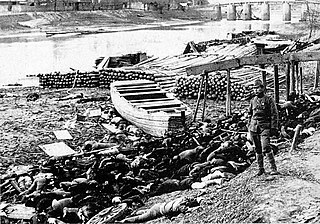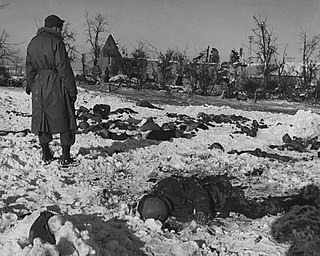It has been suggested that Bioterrorism#Incidents be merged into this article. (Discuss) Proposed since March 2024. |
This is a list of bioterrorist incidents.
It has been suggested that Bioterrorism#Incidents be merged into this article. (Discuss) Proposed since March 2024. |
This is a list of bioterrorist incidents.
The definitions of bioterrorism for the purpose of this article are:
The following criteria of violence or threat of violence fall outside of the definition of this article:
| Date | Incident | Agent | Dead | Injured | Location | Details | Perpetrator | References |
|---|---|---|---|---|---|---|---|---|
| 595–585 BC | Siege of Kirrha | Helleborus (Hellebore) | Unknown | Unknown | Cirrha | During the siege of Kirrha, Solon of Athens added hellebore to the water of the Pleistos and let it flow into Kirrha. | Solon of Athens | [1] |
| 1941-1945 | Unknown | 200 | Unknown | Poland | Unconfirmed reports indicated that the Polish resistance killed 200 German soldiers with biological agents. | Polish resistance | [1] [2] | |
| 1952 | Euphorbia grantii toxin | Unknown | Unknown | British Kenya | During the Mau Mau Uprising, the plant toxin of the African milk bush was used to poison livestock by the Mau Mau. | Mau Mau | [1] | |
| October, 1981 | Operation Dark Harvest | Bacillus anthracis | Unknown | Unknown | Porton Down, United Kingdom | Dark Harvest Commando, a militant group, demanded the British government decontaminate Gruinard Island, a site which had been used for anthrax weapon testing during World War II, by distributing potentially anthrax-laden soil on the mainland. | Dark Harvest Commando | [1] [2] |
| August 29–October 10, 1984 | 1984 Rajneeshee bioterror attack | Salmonella | 0 | 751 | The Dalles, United States | The Rajneeshee cult spreads salmonella in salad bars at ten restaurants in The Dalles, Oregon to influence a local election. Health officials say that 751 people were sickened and more than 40 hospitalized. | Rajneeshee | [3] |
| July–December, 1989 | 1989 California medfly attack | Ceratitis capitata (Medfly) | 0 | 0 | Southern California, United States | During the summer and fall of 1989, several outbreaks of medflies occurred throughout Southern California, particularly in the Los Angeles metropolitan area. The outbreaks devastated crops. | "The Breeders" (Unresolved) | [4] |
| April 1990 | Botulinum toxin | 0 | 0 | Japan | The religious group Aum Shinrikyo outfitted three vehicles to disseminate botulinum toxin at the National Diet Building, Yokosuka naval base and the Narita International Airport | Aum Shinrikyo | [2] | |
| June 28–July 2, 1993 | Kameido Odor Incident | Bacillus anthracis | 0 | 0 | Kameido, Tokyo, Japan | The religious group Aum Shinrikyo released anthrax in Tokyo. Eyewitnesses reported a foul odor. The attack was a failure, due to the fact that the group used the vaccine strain of the bacterium, and no one was infected. | Aum Shinrikyo | [5] |
| September 18–October 12, 2001 | 2001 anthrax attacks | Bacillus anthracis | 5 | 17 | United States | Letters laced with infectious anthrax were concurrently delivered to news media offices and the U.S Congress, alongside an ambiguously related case in Chile. The letters killed 5. | Bruce Edwards Ivins | [6] |
| 2003 | 2003 ricin letters | Ricin | 0 | 0 | United States | Two ricin-laden letters were found on two separate occasions between October and November 2003. One letter was mailed to the White House and intercepted at a processing facility; another was discovered with no address in South Carolina. A February 2004 ricin incident at the Dirksen Senate Office Building was initially connected to the 2003 letters as well. | "Fallen Angel" (Unresolved) | [7] |
| 15–17 April 2013 | April 2013 ricin letters | Ricin | 0 | 0 | Washington, D.C., United States | An envelope that preliminarily tested positive for ricin was intercepted at the US Capitol's off-site mail facility in Washington, D.C. According to reports, the envelope was addressed to the office of Mississippi Republican Senator Roger Wicker. | James Everett Dutschke | [8] [9] |

Biological warfare, also known as germ warfare, is the use of biological toxins or infectious agents such as bacteria, viruses, insects, and fungi with the intent to kill, harm or incapacitate humans, animals or plants as an act of war. Biological weapons are living organisms or replicating entities. Entomological (insect) warfare is a subtype of biological warfare.

Bioterrorism is terrorism involving the intentional release or dissemination of biological agents. These agents include bacteria, viruses, insects, fungi, and/or their toxins, and may be in a naturally occurring or a human-modified form, in much the same way as in biological warfare. Further, modern agribusiness is vulnerable to anti-agricultural attacks by terrorists, and such attacks can seriously damage economy as well as consumer confidence. The latter destructive activity is called agrobioterrorism and is a subtype of agro-terrorism.

State terrorism refers to acts of terrorism which a state conducts against another state or against its own citizens.

Terrorism, in its broadest sense, is the use of intentional violence and fear to achieve political or ideological aims. The term is used in this regard primarily to refer to intentional violence during peacetime or in the context of war against non-combatants. There are various different definitions of terrorism, with no universal agreement about it.
Biodefense refers to measures to restore biosecurity to a group of organisms who are, or may be, subject to biological threats or infectious diseases. Biodefense is frequently discussed in the context of biowar or bioterrorism, and is generally considered a military or emergency response term.

A war crime is a violation of the laws of war that gives rise to individual criminal responsibility for actions by combatants in action, such as intentionally killing civilians or intentionally killing prisoners of war, torture, taking hostages, unnecessarily destroying civilian property, deception by perfidy, wartime sexual violence, pillaging, and for any individual that is part of the command structure who orders any attempt to committing mass killings including genocide or ethnic cleansing, the granting of no quarter despite surrender, the conscription of children in the military and flouting the legal distinctions of proportionality and military necessity.

Chemical warfare (CW) involves using the toxic properties of chemical substances as weapons. This type of warfare is distinct from nuclear warfare, biological warfare and radiological warfare, which together make up CBRN, the military acronym for chemical, biological, radiological, and nuclear, all of which are considered "weapons of mass destruction" (WMDs), a term that contrasts with conventional weapons.

Crimes against humanity are certain serious crimes committed as part of a large-scale attack against civilians. Unlike war crimes, crimes against humanity can be committed during both peace and war and against a state's own nationals as well as foreign nationals. Together with war crimes, genocide, and the crime of aggression, crimes against humanity are one of the core crimes of international criminal law, and like other crimes against international law have no temporal or jurisdictional limitations on prosecution.

A civilian casualty occurs when a civilian is killed or injured by non-civilians, mostly law enforcement officers, military personnel, rebel group forces, or terrorists. Under the law of war, it refers to civilians who perish or suffer wounds as a result of wartime acts. The term is generally applied to situations in which violence is committed in pursuit of political goals. During periods of armed conflict, there are structures, actors, and processes at a number of levels that affect the likelihood of violence against civilians.

The law of war is the component of international law that regulates the conditions for initiating war and the conduct of hostilities. Laws of war define sovereignty and nationhood, states and territories, occupation, and other critical terms of law.

Ricin ( RY-sin) is a lectin (a carbohydrate-binding protein) and a highly potent toxin produced in the seeds of the castor oil plant, Ricinus communis. The median lethal dose (LD50) of ricin for mice is around 22 micrograms per kilogram of body weight via intraperitoneal injection. Oral exposure to ricin is far less toxic. An estimated lethal oral dose in humans is approximately one milligram per kilogram of body weight.

The just war theory is a doctrine, also referred to as a tradition, of military ethics that aims to ensure that a war is morally justifiable through a series of criteria, all of which must be met for a war to be considered just. It has been studied by military leaders, theologians, ethicists and policymakers. The criteria are split into two groups: jus ad bellum and jus in bello. The first group of criteria concerns the morality of going to war, and the second group of criteria concerns the moral conduct within war. There have been calls for the inclusion of a third category of just war theory dealing with the morality of post-war settlement and reconstruction. The just war theory postulates the belief that war, while it is terrible but less so with the right conduct, is not always the worst option. Important responsibilities, undesirable outcomes, or preventable atrocities may justify war.
The concept of justifiable homicide in criminal law is a defense to culpable homicide. Generally, there is a burden to produce exculpatory evidence in the legal defense of justification.
There is no consensus, scholarly or legal, on the definition of terrorism.
Cyberterrorism is the use of the Internet to conduct violent acts that result in, or threaten, the loss of life or significant bodily harm, in order to achieve political or ideological gains through threat or intimidation. Acts of deliberate, large-scale disruption of computer networks, especially of personal computers attached to the Internet by means of tools such as computer viruses, computer worms, phishing, malicious software, hardware methods, programming scripts can all be forms of internet terrorism. Cyberterrorism is a controversial term. Some authors opt for a very narrow definition, relating to deployment by known terrorist organizations of disruption attacks against information systems for the primary purpose of creating alarm, panic, or physical disruption. Other authors prefer a broader definition, which includes cybercrime. Participating in a cyberattack affects the terror threat perception, even if it isn't done with a violent approach. By some definitions, it might be difficult to distinguish which instances of online activities are cyberterrorism or cybercrime.
In the United States, domestic terrorism is defined as terrorist acts that were carried out within the United States by U.S. citizens and/or U.S. permanent residents. As of 2021, the United States government considers white supremacists to be the top domestic terrorism threat.
The tactics of terrorism are diverse. As important as the actual attacks is the cultivation in the target population of the fear of such attacks, so that the threat of violence becomes as effective as actual violence. The different tactics that terrorist groups utilize can be very simple to extremely complex.

In 1984, 751 people suffered food poisoning in The Dalles, Oregon, United States, due to the deliberate contamination of salad bars at ten local restaurants with Salmonella. A group of prominent followers of Rajneesh led by Ma Anand Sheela had hoped to incapacitate the voting population of the city so that their own candidates would win the 1984 Wasco County elections. The incident was the first and is still the single largest bioterrorist attack in U.S. history.
Entomological warfare (EW) is a type of biological warfare that uses insects to interrupt supply lines by damaging crops, or to directly harm enemy combatants and civilian populations. There have been several programs which have attempted to institute this methodology; however, there has been limited application of entomological warfare against military or civilian targets, Japan being the only state known to have verifiably implemented the method against another state, namely the Chinese during World War II. However, EW was used more widely in antiquity, in order to repel sieges or cause economic harm to states. Research into EW was conducted during both World War II and the Cold War by numerous states such as the Soviet Union, United States, Germany and Canada. There have also been suggestions that it could be implemented by non-state actors in a form of bioterrorism. Under the Biological and Toxic Weapons Convention of 1972, use of insects to administer agents or toxins for hostile purposes is deemed to be against international law.
{{cite news}}: CS1 maint: unfit URL (link){{cite journal}}: CS1 maint: multiple names: authors list (link)